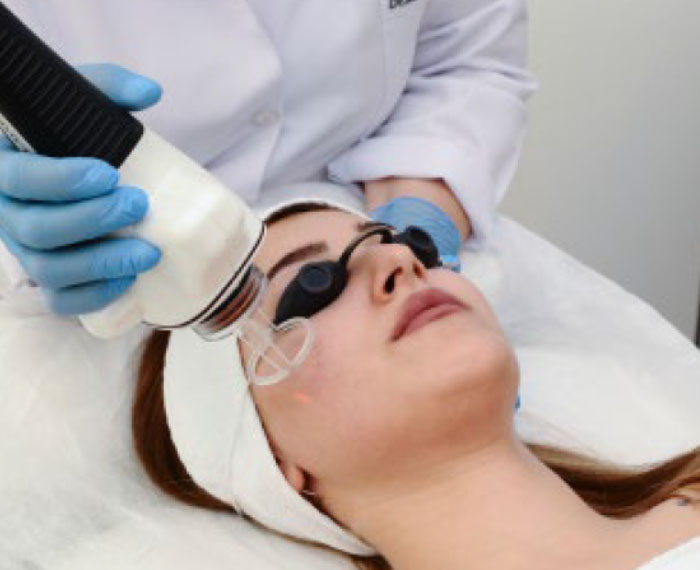
Fractional CO2 Laser Procedures
• Skin ablation
• Skin rejuvenation
• Stria
• Fine wrinkles
• Pore frming
• Acne scars
• Wound scars
• Surgical scars
Fractional laser is an advanced laser system that transmits high energy to the skin in the form of columns. In this method, intact tissue remains around the small damage areas, and these areas heal quickly. Fractional laser system triggers natural wound healing and collagen synthesis due to the heat and coagulation it creates in the applied area, and provides new and healthy tissue formation. In other words, while tightening the collagen strips, the subsequent collagen production increases. As a result, a fresher skin appearance and tightening are achieved. Most importantly, it provides a reduction in scars, stains, cracks and wrinkles.
Previously, the amount of energy required for laser scar removal and skin rejuvenation procedures could not be applied to the patient due to undesirable effects. With the development of the fractional laser system, it became possible to apply high doses of energy without causing discomfort to the person. This application is acne scars or pits on the face, back and chest; It is the strongest and most effective treatment method for wounds, burn scars and skin cracks.
In our clinic, the application is made with the carbon dioxide fractional laser type included in this system.
places of use
Skin rejuvenation and facial rejuvenation
The carbon dioxide fractional laser provides the recovery and tightening of the applied area on the top layer of the skin. It is the most effective method for removing wrinkles and lines on the face, eyelids, neck and décolleté.
This application involves the controlled peeling of the upper layer of the skin; It allows the aged, damaged skin surface to be replaced by a new and smooth skin. The large-pored and coarse appearance of the skin is removed, and a younger appearance is obtained on the face. Although facial wrinkles can be eliminated by skin regeneration, it is one of the best forms of treatment, especially for wrinkles created by the sun around the lips and eyes.
Stretch mark treatment
Stretch marks are a kind of scarring of the skin and subcutaneous tissue. Like scars, there is no full treatment for cracks, but the prominence of cracks can be significantly reduced in 5-6 sessions with fractional laser. This application is also used in the treatment of post-pregnancy cracks.
Treatment of acne scars
Superficial acne scars: These are the scars that affect the upper layer of the skin. These scars occur especially after acne treatment and are seen as light pits or collapses on the redness background. Treatment of superficial and non-healing acne scars is possible with carbon dioxide fractional laser.
Deep acne scars: There may be round or oval-shaped or pit-shaped acne scars as if perforated on the skin. These types of acne scars, which are usually deep, are caused by the upper layer of the skin being pulled inward by the lower layers. In deep acne scars, the “Subcision” process is applied before the laser, if necessary. In this type of acne scars, which are the most difficult to treat, a great improvement is observed with carbon dioxide fractional laser.
spot treatment
Spot treatment takes time and the type of stain is also important in the success of the treatment. Sun exposure is an important factor that triggers blemishes. With the carbon dioxide laser, sun, pregnancy and age spots can be treated to a great extent.
Scar treatment
All types of injuries cause varying degrees of scarring on the skin. This laser system gradually melts the tissue in the scar area in each session, allowing the new and trouble-free skin tissue right next to the wound to repair this area. The scar shrinks with each session and becomes at least cosmetically acceptable. Small scars may disappear completely. In scar treatments, these lasers are the most preferred system in the world due to the least side effects and the fastest recovery time.
Preparation of the skin
The patient should stay away from the sun and solarium for a month before the application. Drugs that prevent blood clotting such as aspirin, heparin, tetracycline, naproxen, estrogen, progesterone, birth control pills, drugs that cause photosensitivity such as chloroquine should not be taken. If treatments such as skin abrasive dermabrasion and peeling or skin stretching have been applied before the application, it must be specified. If the patient has a history of herpes in the past, he should definitely take medication before the application.
Fractional laser functions by triggering the tissue’s natural wound healing and collagen synthesis. Some maintenance agents are also required for collagen synthesis. It is recommended to care for the skin with medical products and sunscreen for about 1 week before laser application, in order to accelerate the healing process and get better results.
Application and after
Before the procedure, the skin is prepared for application with anesthetic creams. There is a slight burning sensation during the procedure, after which redness and tenderness occur in the application area. There is redness on the skin on the day and after the procedure, and a slight crusting is observed on the 3rd and 4th days. After this period, the person can return to his normal life.
During this four-day period, it is recommended that patients use creams and sunscreen that accelerate wound healing. Depending on the problem, the treatment can be repeated 3-6 times at intervals of 4 or 5 weeks.
